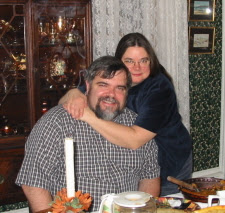 One of the strange and uncomfortable aspects of being a pastor with cancer is the reversal of roles. Congregations look to their ministers to be strong, to be there for them in all circumstances, to present the sort of reliable public image pastoral-care professors describe as a “non-anxious presence.” Yet, when we fall sick, our human frailty is suddenly out there, for all to see.
One of the strange and uncomfortable aspects of being a pastor with cancer is the reversal of roles. Congregations look to their ministers to be strong, to be there for them in all circumstances, to present the sort of reliable public image pastoral-care professors describe as a “non-anxious presence.” Yet, when we fall sick, our human frailty is suddenly out there, for all to see.That’s not a bad thing. I’d be the last one to pretend to any sort of invincibility. Some congregants may be eager to put their preachers on a pedestal, but that’s certainly not where we belong.
Most ministers have had the experience of hearing the parents of some young child confide, with a sheepish grin, that their son or daughter actually thinks we’re God (or, at least, Jesus). Parents shouldn’t be dumbfounded when their children come up with such an idea. After all, they teach their kids the church is God’s house, don’t they? When they bring them there, what do the children see? They see a person standing up front, lifted high, set apart from the rest of the people. This person is wearing strange garments and speaks with a booming voice (assisted by a microphone, though the kids don’t know that). Deeper than that, many children are highly intuitive. They pick up on the psychological dynamic, in their family system, known as “projection.” Knowing that their parents revere God, they transfer – or project – that authority onto us, the people who have the most prominent role in church.
 It’s not only young children who do this. Some adult church members, consciously or unconsciously, strive mightily to do the same to their ministers. Sometimes, in a limited way, this can be in service to the Gospel – as people use us as a sort of transitional stepping-stone on the way to God, the only true object of devotion. At other times, it can verge on the pathological. A few people place such unreasonable expectations on their ministers, that when those hopes are inevitably dashed, they either lash out against us or depart for another church (where, as often as not, they begin the projection-and-disappointment cycle all over again).
It’s not only young children who do this. Some adult church members, consciously or unconsciously, strive mightily to do the same to their ministers. Sometimes, in a limited way, this can be in service to the Gospel – as people use us as a sort of transitional stepping-stone on the way to God, the only true object of devotion. At other times, it can verge on the pathological. A few people place such unreasonable expectations on their ministers, that when those hopes are inevitably dashed, they either lash out against us or depart for another church (where, as often as not, they begin the projection-and-disappointment cycle all over again).Cancer has exposed my own feet of clay, for all to see. It’s a fascinating phrase, “feet of clay.” It comes from a little-known biblical reference, Daniel 2:31-40, in which the prophet interprets a dream of King Nebuchadnezzar. It’s a dream about a monumental royal statue, coated in precious metals and iron, but with feet of clay. A great stone strikes the feet of clay, which causes the statue itself to collapse. Daniel, of course, interprets this vision as a bad omen for the future of the Babylonian king’s dynasty.
 When we say a person has “feet of clay,” we mean he or she is only human. Clay, according to the Genesis creation story, is the material out of which God fashioned the first humans. African-American poet James Weldon Johnson envisions that scene in these powerful words from his poem, The Creation:
When we say a person has “feet of clay,” we mean he or she is only human. Clay, according to the Genesis creation story, is the material out of which God fashioned the first humans. African-American poet James Weldon Johnson envisions that scene in these powerful words from his poem, The Creation:“Up from the bed of the river
God scooped the clay;
And by the bank of the river
He kneeled Him down;
And there the great God Almighty
Who lit the sun and fixed it in the sky,
Who flung the stars to the most far corner of the night,
Who rounded the earth in the middle of His hand;
This great God,
Like a mammy bending over her baby,
Kneeled down in the dust
Toiling over a lump of clay
Till he shaped it in his own image;
Then into it he blew the breath of life,
And man became a living soul...”
We are clay: all of us, ministers and laypeople alike. But we also have within us the breath of the Spirit. It’s but one more lesson cancer teaches.
















